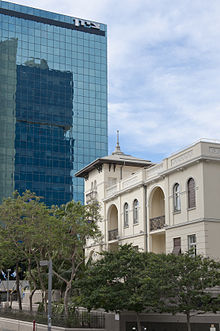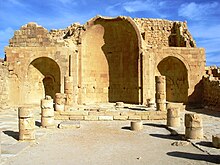This is an old revision of this page, as edited by 103.37.181.21 (talk) at 10:04, 8 March 2019 (→External links). The present address (URL) is a permanent link to this revision, which may differ significantly from the current revision.
Revision as of 10:04, 8 March 2019 by 103.37.181.21 (talk) (→External links)(diff) ← Previous revision | Latest revision (diff) | Newer revision → (diff)

The architecture of Israel has been influenced by the different styles of architecture brought in by those who have occupied the country over time, sometimes modified to suit the local climate and landscape. Fortified Crusader castles, Islamic madrassas, Byzantine churches, Templer houses, Arab arches and minarets, Russian Orthodox onion domes, Bauhaus-style modernist buildings, sculptural concrete Brutalist architecture, and soaring glass-sided skyscrapers all are part of the architecture of Israel.
Architectural styles
The Arabs built small stone houses on the hillsides with flat or dome roofs. The Crusaders built fortresses on strategic hilltops. The Christians built churches to mark sites where Jesus walked. The Templers built homes with tiled roofs like those in the German countryside. The British Mandatory authorities passed a law requiring all construction in Jerusalem to be of Jerusalem stone and introduced the idea of garden suburbs. In the early years of statehood, Israel built rows of concrete tenements to accommodate the masses of new immigrants to replace the huts, tents and packing crates of the maabarot. First named the "White City" in 1984, the White City of Tel Aviv has been declared a UNESCO World Heritage Site. As property values have risen, skyscrapers are going up around the country. The Azrieli Sarona Tower in Tel Aviv is the tallest building in Israel to date.
Leading architects
Sensing the political changes taking place in central Europe around the time of the First World War, as well as the stirrings of Zionist ideals about the re-establishment of a homeland for Jews, numerous Jewish architects from around Europe emigrated to Palestine during the first three decades of the 20th century. While much innovative planning occurred during the time of the British Mandatory authorities, 1920-1948, in particular the town plan for Tel Aviv in 1925 by Patrick Geddes, it would be architecture designed in the modernist "Bauhaus" style that would fill the plots of that plan; among the architects who emigrated to Palestine at that time, and who went on to establish formidable careers were: Yehuda Magidovitch, Shmuel Miestechkin, Lucian Korngold, Jacov Ornstein, Salomon Gepstein, Josef Neufeld and Genia Gideoni.
Dov Karmi, Zeev Rechter and Arieh Sharon were among the leading architects of the early 1950s. Rudolf (Reuven) Trostler played an important role in designing the country's early industrial buildings. Dora Gad designed the interiors of the Knesset, the Israel Museum, the country's first large hotels, the Jewish National and University Library, El Al planes and Zim passenger ships.Amnon Niv designed Moshe Aviv Tower, Israel's tallest building. David Resnick was a Brazilian-born Israeli architect who won the Israel Prize in architecture and the Rechter Prize for iconic Jerusalem buildings such as the Israel Goldstein Synagogue and Brigham Young University on Mount Scopus.

Historical developments
Traditional rural house


Until the end of the 19th century, the traditional Arab rural house in the villages of what was then Palestine consisted of a single room without partitions, divided into levels in accordance with various functions carried out in the house:
- Rawiyeh – a bottom level at the elevation of the courtyard considered the “dirty” part of the house, used for storage and sheltering livestock.
- Mastabeh – A higher residential level used for sleeping, eating, hospitality and storage.
- Sida (gallery) – Another living area above the mastaba, used primarily for sleeping.
In the second half of the 19th century, a residential story characterized by a cross-vault was added above the traditional house, creating a space between the floor with the livestock in the bottom room and the residential story. A separate entrance was installed in each story.
Fortified house
Fortified houses were built outside the village core and had two stories: a raised ground floor with tiny windows used for raising livestock and storage, and a separate residential floor with large windows and balconies. In the courtyard was a small structure used for storage. Sometimes a tabun baking oven would be located inside it.
Farmhouses
The first modern building technology was evident in the farmhouses. Iron beams were used and the roofs were made of concrete and roof tiles. These structures had balconies with a view and wide doorways.
Modern housing (British Mandate)

Modern housing built during the British Mandate was urban in character, with flat roofs, rectangular doorways and painted floor tiles.
Biomorphism, blob architecture

The Pavie House in Neve Daniel is a rare case of non geometric biomorphic architecture (blobitecture) in Israel. Yonatan Kanti of the Israeli daily Ma'ariv compared Pavie architectural style to the futurism of Eero Saarinen's TWA Flight Center.
Movie theaters
The architecture of Tel Aviv's movie theaters can be seen as a reflection of Israeli architectural history: The first cinema, the Eden, opened in 1914, was an example of the eclectic style that was in vogue at the time, combining European and Arab traditions. The Mugrabi cinema, designed in 1930, was built in art deco style. In the late 1930s, the Esther, Chen and Allenby theaters were prime examples of the Bauhaus style. In the 1950s and 1960s, brutalist style architecture was exemplified by the Tamar cinema built inside the historic Solel Boneh building on Allenby Street.
The Politics of Architecture
The persistent existential threat posed by rival ideologies impacts how architecture is used as a powerful means of determining who gets to control and use land in Israel. Eyal Weizman advances a detailed argument concerning how the power relations expressed through architecture explain built form. .
State of Israel
From 1948, architecture in Israel was dominated by the need to house masses of new immigrants. The Brutalist concrete style suited Israel's harsh climate and paucity of natural building materials. Municipal laws in Jerusalem require that all buildings be faced with local Jerusalem stone. The ordinance dates back to the British Mandate and the governorship of Sir Ronald Storrs and was part of a master plan for the city drawn up in 1918 by Sir William McLean, then city engineer of Alexandria.
Museums and archives
A small Bauhaus Museum was established in Tel Aviv in 2008. The Munio Gitai Weinraub Museum of Architecture opened in Haifa in 2012.
See also
References
- Encyclopedia of Zionism and Israel, edited by Raphael Patai, Herzl Press, McGraw, New York, 1971 "Architecture and Town Planning in Israel," Vol. 1, pp. 71-76
- ^ A Concrete Life, Noam Dvir, Haaretz Magazine, October 17, 2008
- Dora Gad's private sanctuary
- Encyclopedia Judaica, 2008, as quoted by Jewish Virtual Library, retrieved September 13, 2012
- Brittain-Catlin, Timothy, "Israel Goldstein Synagogue, Givat Ram campus of the Hebrew University, Jerusalem, Israel Heinz Rau and David Reznik", Building of the Month, Twentieth Century Society, June 2010, retrieved September 13, 2012
- Dvir, Noam, "A mixed modernist message," Haaretz, February 2, 2012, retrieved September 13, 2012
- ^ Heritage Conservation in Israel
- Kanti, Yonatan (2 April 2012). השראה למכירה: המקרה המוזר של הבית בגוש עציון [Inspiration for sale: The curious case of the house in Gush Etzion]. Nrg Maariv (in Hebrew). Retrieved 7 April 2012.
- Architectural milestones
- Weizman, Eyal (2007). Hollow Land: Israel's architecture of occupation (First ed.). New York: Verso.
{{cite book}}:|access-date=requires|url=(help) - Sir Banister Fletcher's A History of Architecture
- PAUL GOLDBERGERPublished: September 10, 1995 (1995-09-10). "Passion Set in Stone, New York Times, Sept. 10, 1995". New York Times. Retrieved 2012-08-28.
{{cite web}}: CS1 maint: numeric names: authors list (link) - "Jerusalem Architecture Since 1948". Jewishvirtuallibrary.org. Retrieved 2012-08-28.
- The British Mandate from "Jerusalem: Life Throughout the Ages in a Holy City". Online course material from the Ingeborg Rennert Center for Jerusalem Studies, Bar-Ilan University, Ramat-Gan, Israel
- Hecht, Esther. "Bauhaus Museum Opens in Tel Aviv's White City". Architectural Record. Retrieved 5 September 2012.
- Amos Gitai sets up Israel's first architecture museum in memory of his father, Haaretz
n
External links
- JewishVirtualLibrary.org: Archaeology
- Arzaworld.com: Historical Architecture and Design in Israel
- A little modesty goes a long way — by David Kroyanker.
- [http://www.mfa.gov.il/MFA/MFA+Publications/Photo+exhibits/Fifty+Years+of+Israeli+Architecture+as+Reflected+i.htm?DisplayMode=print Fifty years of
- Israel Architect Design
- Architecture of Israel Quarterly
- "Jerusalem: Architecture in the late Ottoman Period" — by Lili Eylo